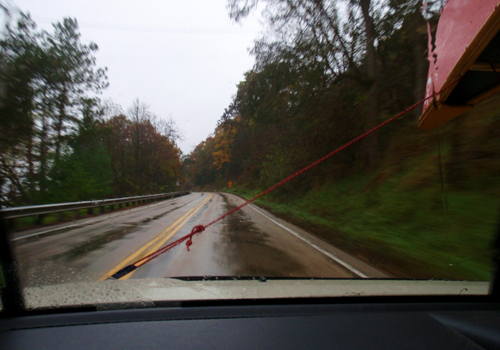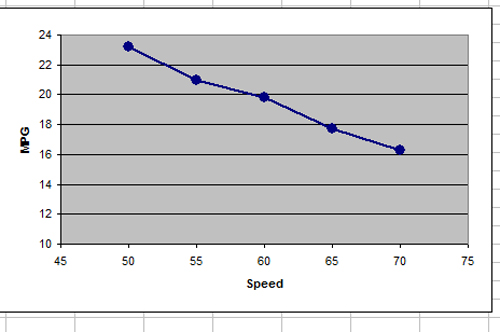
On the way back from a recent canoe trip I was zipping along at 71.3 mph without a care in the world. Until I looked down at my mileage indicator… 16.3.
That’s sick. Yeah, I had a big fat canoe on the top of the car, but really? 16.3?
That’s when I thought of doing a little experiment. I reset the mileage indicator, put the cruise control at 70 and measured for five miles. Then at 65, 60, 55 and for just for yucks, 50. The results were surprising.

GAL/M is gallons per mile, CPG is cost per gallon, CPM is cost per mile.
If you’re a more visual person:

Scary cool takeaways:
1. It costs me 21 cents a mile in fuel only if I drive 70. If I slow down to a moderate 60, I save 4 cents a mile. No big deal, but at 15,000 miles a year…it’s about 600 bucks a year. If I drive 55…that savings goes to $750.
2. If I get 16.3 mpg and drive 15,000 miles a year, I am burning 920 gallons of gas a year. That’s a lot of gas. If I get 19.8 mpg, I burn 757 gallons.
3. If everyone did this…the results would be dramatic.
Instead of whining about gas prices, how about we all just slow down? President Obama could re-institute the Carter era 55 mph national speed limit, done at that time to save fuel and to help us achieve independence from OPEC. It was a political act as well as an environmental act.
Granted, some of the Tea Party people would scream that speed limits aren’t listed in the Constitution, and that the Founding Fathers did not want to restrict the freedom of people to go really fast. They also didn’t specify that anyone without a reasonable understanding of history should get a lobotomy. Maybe they should have thought of that.
When Reagan was elected one of his first acts was to eliminate the speed limits. “We shouldn’t be in the business of telling states how fast their citizens can drive,” or something like that. Okay, sure. Oil companies loved this. It was an adolescent “you’re not the boss of me” statement, and just about as mature.
The immediate effect would be staggering. Gas prices would fall within weeks. We would produce less greenhouse gas. And best of all, we’d all slow down a little. We’d see things on the side of the road, take roads less traveled and relax a little.
Coming back from delivering a boat to Milwaukee last night, I took the interstate there. 18.2 mpg. Coming home — Highway 18, winding through picturesque towns and along beautiful little lakes. I had to slow down to 35 five or six times as I passed through a hamlet. It was no hardship.
Gas mileage coming home: 22.8. Extra time taken (measured by the GPS): 13 minutes. That’s 13 extra minutes I got to spend holding hands with my wife.
Think about it, America. Slow is patriotic. And it’s better for your brain. And you get to see more scenery like this.

Instead of this.

Respectfully submitted,
Canoelover

With or without a canoe this is smart. Especially when driving short distances. I figured that on the 5 miles of expressway I take to work, driving 65 (5 under) instead of 75 (5 over) only costs me 36 seconds. Fuel costs, not to mention the cost of a ticket make it a no brainer.
Some of this is car and boat placement. On one 8 hour trip we only had one canoe so I centered thinking it would help aerodynamics, but I got a few MPG less than I have gotten with 2 canoes before. We took my wifes car (Caviler) with a canoe from MI to NC a few years ago and averaged 36MPG for the trip, which included 4 days driving in the mountains and around town.
Once, on the way back from Rutabaga (a little known paddle shop in Wisconsin) I enjoyed a tailwind that allowed my Forester (usually 25-27 pg) to hit 40 mpg. Perhaps one of those sail rigs for kayaks could be installed and deployed when driving before the wind.
Um…You can drive as slow as you want. Just don’t get in front of me! (And don’t inflict a national speed limit slowing me down.)
No hard feelings?
*sits smugly* My wee diesel Toyota does 65mpg normally, 55 with a canoe on, 🙂